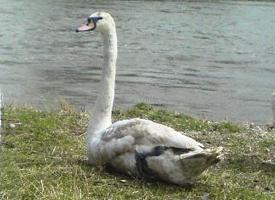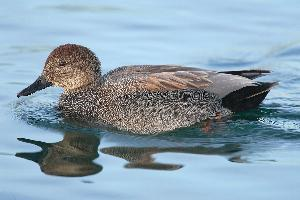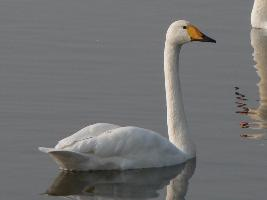
Poids et mesures
| Longueur | de 145 à 160 cm |
|---|---|
| Poids | de 8 à 12,5 kg |
| Envergure des ailes | 235 cm |
Description de l'animal
The Mute Swan (Cygnus olor) is a species of swan, and is one of the most familiar and easily recognizable waterfowl in the world due to its striking appearance and widespread presence across various parts of the globe. Although it is native to much of Europe and Asia, it has been introduced to other regions such as North America and Australasia, where it is often found in parks, lakes, and estuaries. This bird is celebrated for its grace and beauty, frequently featured in mythology, literature, and ballets like Tchaikovsky's "Swan Lake."Adult Mute Swans are large birds, measuring between 140 to 160 centimeters in length, with a wingspan that can exceed 240 centimeters, making them one of the largest waterfowl. They weigh approximately 12 kilograms, with males (known as cobs) being slightly larger than females (pens). Their size and the distinctive knob atop their beaks can help differentiate them from other swan species.
The plumage of the Mute Swan is entirely white, a feature that adds to their elegance and makes them a symbol of purity in many cultures. Their beaks are orange-red with a prominent black base and a noticeable knob that becomes more pronounced in males during the breeding season. Their legs and feet are blackish-grey. Juveniles are not as striking, with greyish-brown feathers that gradually turn white as they mature over the first year.
Mute Swans are known for their characteristic "S" shaped neck, which they often hold erect while swimming. Unlike other swans, they are not vocal, hence the name "mute." However, they are capable of making a range of sounds such as grunts, whistles, and snorts, especially when communicating with their cygnets or during aggressive encounters.
These swans are monogamous birds, forming bonds that last for many years, and in some cases, for life. Their nests are large mounds of vegetation built near the edge of a water body. The female lays between 5 to 7 eggs, which are incubated for about 36 days. Both parents are involved in raising the cygnets, which are able to swim and feed themselves shortly after hatching but remain with their parents for several months.
Mute Swans feed primarily on aquatic vegetation, which they obtain by dipping their heads underwater to reach plants on the lake or riverbed. They may also feed on insects, frogs, and small fish. In urban areas, they are often seen consuming bread and other food provided by humans, although this is not a natural part of their diet and can be harmful.
Despite their serene appearance, Mute Swans can be quite territorial, especially during the breeding season. They are known to aggressively defend their nests and young from perceived threats, including humans who venture too close.
Conservation-wise, the Mute Swan is considered to be of least concern by the International Union for Conservation of Nature (IUCN), thanks to its wide distribution and large, stable population. However, they face threats from habitat loss, pollution, and lead poisoning from ingested fishing weights.
In summary, the Mute Swan is a majestic and iconic bird, celebrated for its beauty and elegance. Its presence across lakes, rivers, and ponds adds a touch of grace to these environments, making it a cherished species among bird enthusiasts and nature lovers alike.
Animaux similaires
Nouvelles photos d'animaux
Top 10 des animaux
- Dolphin gull (Leucophaeus scoresbii)
- Diana monkey (Cercopithecus diana)
- Moustached guenon (Cercopithecus cephus)
- Galápagos tortoise (Geochelone nigra complex)
- Japanese macaque (Macaca fuscata)
- Russian tortoise (Testudo horsfieldii)
- Stone loach (Barbatula barbatula)
- Greek tortoise (Testudo graeca)
- Common flying dragon (Draco volans)
- Vendace (Coregonus albula)


